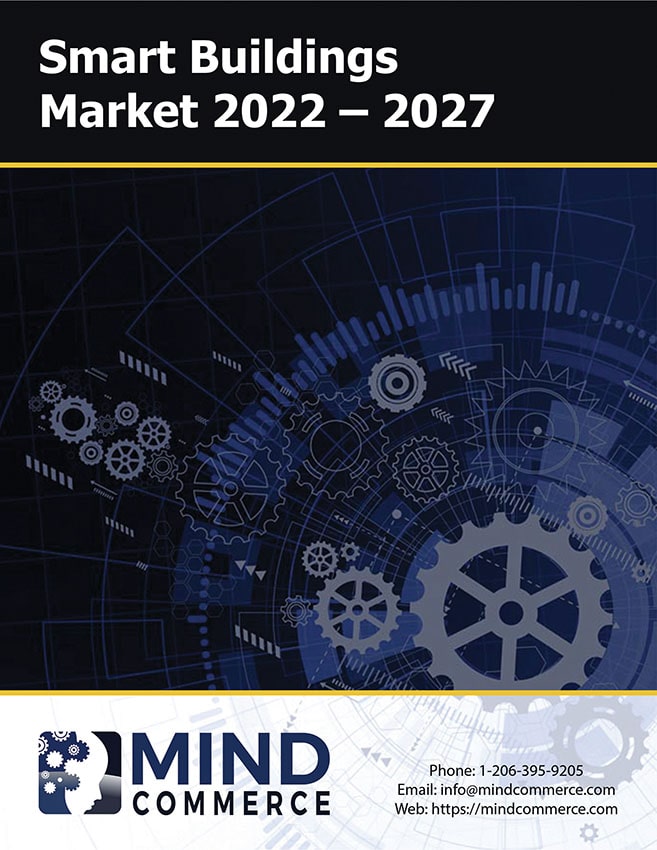Description
Collectively speaking, residential dwellings, offices, educational campuses, indoor recreation and public service facilities are where people in the developed world spend up to to 90% of their time. As urbanization leads to increasingly smarter cities, buildings are an integral part of a city’s ecosystem and are increasingly shaping both the standard of living and quality of life of inhabitants. Intelligent buildings lead to improved economics for both owners and users as well as improved satisfaction, safety, and well-being of occupants. The smart buildings market consists of warehouses, factories, office buildings and other enterprise, industrial, and government structures. Improving the operational effectiveness and efficiency, safeguarding assets, and establishing new value-added services are a few of the fundamental goals of smart buildings.
The smart buildings market consists of warehouses, factories, office buildings and other enterprise, industrial, and government structures. Intelligent structures leverage a variety of interdependent technologies such as Artificial Intelligence (AI), broadband wireless (including WiMAX, LTE, 5G, and indoor wireless such as improvements coming with WiFI version 6), cloud computing (including edge computing), and Internet of Things (IoT) networks and systems to improve operational efficiency and enable a safer and more productive environment. These are all tangible, measurable goals upon which the success of the smart buildings market is judged from an ROI perspective.
The smart buildings market is related to the smart workplace market, which includes some important enterprise and industrial automation systems and solutions such as integrated workplace management systems (IWMS), decision support systems utilizing advanced data analytics, and business asset management. Mind Commerce sees IWMS solutions as crucial to the smart buildings market, as enterprise organizations are able to optimize asset utilization, energy consumption, technology deployment, building and infrastructure efficiency, and overall workplace productivity to gain substantial savings in CAPEX and OPEX. Mind Commerce sees the confluence of AI and IoT (AIoT) having a particularly large positive impact on the IWMS solutions market.
Leading companies within the commercial real estate sector are realizing tangible benefits by leveraging smart buildings market solutions as owners are able to charge higher fees for technology-enabled intelligent buildings. Accordingly, over 75% of new construction will involve at least one facet of IoT and/or related smart buildings market related technologies over the course of the next five years. However, it is important to note that roughly 85% of legacy buildings in developed economies have issues that will require substantial retrofitting. Mind Commerce sees this statistic improving over time, but remains a major head-wind in terms of capital investment for the smart buildings market.
Smart Buildings Market Dynamics
Defining the Smart Buildings Market
The term smart or intelligent building refers to an Enterprise structure that is supported by software and systems to ensure more efficient and effective operations. Additional goals are to enhance the health and well-being and protect enterprise assets. Intelligent buildings are also closely associated with the concept of the smart workplace, which extends beyond a centralized work zone to include distributed and remote employees and corporate assets.
Commercial real estate owners are able to charge higher lease fees for intelligent buildings for a variety of reasons including lower operational costs as well as support for improved safety, comfort, security, and productivity for workers. Smart workplace benefits facilitated by intelligent buildings include work process improvement, work flow improvement, internal and external supply chain management optimization.
Smart Buildings Market Data Analytics will Emerge through AI and IoT Convergence
The term smart or intelligent building refers to an enterprise structure that is supported by software and systems to ensure more efficient and effective operations. Additional goals of the smart buildings market are to enhance the health and well-being and protect enterprise assets. Intelligent buildings are also closely associated with the concept of the smart workplace, which extends beyond a centralized work zone to include distributed and remote employees and corporate assets. Smart buildings are also integrated beyond IWMS to include data analytics and AI-based decision support systems that allow enterprise systems such as ERP, SCM, and other logistics areas to more fully respond to both resource needs and operational changes within commercial building infrastructure.
An important factor driving investment in the smart buildings market remains the fact that commercial real estate owners are able to charge higher lease fees for intelligent buildings for a variety of reasons including lower operational costs as well as support for improved safety, comfort, security, and productivity for workers. This is a major factor in certain urban environments such as Seattle, Washington in which rapid growth is occurring due to high-tech company growth from the likes of Amazon, which desires the most efficient facilities possible. Smart workplace benefits facilitated by intelligent buildings include work process improvement, workflow improvement, internal and external supply chain management optimization.
Integrated Workplace Management System crucial to Smart Building Operations
The most efficient and effective structures within the smart buildings market are those that include an Integrated Workplace Management System (IWMS). An IWMS solution is leveraged to both support a more integrated building control system as well as optimizing the workplace. This includes orchestrating workflow in processes relative to smart buildings market resources and the environment in terms of things like optimal lighting, heating, and ventilation for workers.
IWMS solutions rely heavily upon IoT technology and data processing for optimal operation. The integration of AI can make these systems more efficient. For example, AI I can assist IWMS solutions in determining optimal allocation of building resources based on environmental factors, workflow, and the availability and location of personnel and organizational assets. This is particularly useful in a corporate campus environment or university where there are multiple buildings that are often multi-purpose and shared among departments.
Emerging Developments in the Smart Buildings Market since the Last Report
Mind Commerce anticipates that the economic environment of the next five years will be characterized as asset deflation and commodity inflation, which will place a high degree of emphasis on maximizing the value of depreciating assets while reducing the cost of inputs to production, service delivery, and reducing commodities as a whole. In other words, enterprise asset values will go down while operational input costs for materials and energy will go up.
It is estimated that urbanization will cause up to 47% of global resources to be consumed by residential and commercial buildings by 2027. Of this amount, over 65% of global energy (mostly electricity, but also natural gas and fuel oil) will be used by enterprise and industrial facilities along with over 30% of the overall global water consumed. This will put a substantial drain on increasingly more expensive and scarce resources as well as the bottom line of corporations.
As asset tracking is increasingly becoming an important aspect of overall enterprise and industrial operations, the smart building market is viewed as the focal point for a variety of corporate capital infrastructure governance, including monitoring, traceability, and accountability for custody of care, utilization, and performance. Accordingly, there is an emerging market opportunity for integration of asset tracking solutions with IWMS and other building related systems.
As companies begin to open-up operations in the wake of the COVID-19 pandemic, building operation managers will be tasked with identifying the most efficient and effective means of determining if personnel should be allowed in offices and other places of work. In addition, ongoing monitoring will be required to determine if someone has potentially become ill. Accordingly,many of the smart building systems put in place to monitor workspace utilization will be augmented and expanded to include thermal imaging and other tools to help in this regard.
Smart Buildings Market Report
This report evaluates the smart buildings market including technologies, players, and solutions. The report analyzes smart buildings challenges and opportunities, assesses market potential, and provides accompanying smart buildings market sizing, globally as well as regionally, and by market segment for 2022 – 2027. The report includes analysis of technologies supporting smart building automation, IWMS, and smart workplace applications and services. Smart building solution areas covered include 5G, AI, data analytics, and edge computing.






